Change Page: 123 > | Showing page 1 of 3, messages 1 to 20 of 44 - powered by ASPPlayground.NET Forum Trial Version
Reports tied to this Journal
Author
|
Message

|
 Breeding Journal, Species: Centropyge argi
Monday, May 5, 2014 8:25 AM
Breeding Journal, Species: Centropyge argi
Monday, May 5, 2014 8:25 AM
( permalink)
Breeding Journal DataSheet
This first post should be updated regularly to include new information as events take place or changes are made to your system General Species: Centropyge argi Social Structure: Harem (trio for me) Size of Individuals: ~2 inch male, ~1.5 inch female, ~1 inch female Age of Individuals: Unknown, wild caught Date added to Tank: 4-26-2014 (but were kept together in quarantine before that) Broodstock Tank Details Size of Tank: 20 gallon high Substrate Details: None Filtration Details: Bioballs, protein skimmer, macro algae, live rock Water Changes: As needed Water Temperature: ~80 F Lighting: Fluorescent strip light (ambient) and CFL Lighting Cycle: 6AM to 9PM Other Tank Inhabitants: None Broodstock Feeding Details Food Types: Mysis, enriched artemia, live artemia (usually bbs), frozen mash, pellet, live blackworms Feeding Schedule: At least 2 times a day Spawning Details Date of First Spawn: 5-4-2014 (First that I noticed/checked for) Spawn Time of Day: Evening, around lights out Dates of Consecutive Spawns: 5-5-2014, 5-7-2014 Courtship Details: Not witnessed Egg Size: ~500uM Egg Color: Clear Egg Count: Less than 50 Hatch Details Hatch Date: 5-5-2014 Hatch Time of Day: Mid day to early evening (uncertain since I was not home to check frequently) # Days after Spawn: Less than 24 hours Larvae Description: Prolarvae, clear, large yolk sac, oil globule Consecutive Hatch Dates: Larval Tank Details Temperature: 80F Size of Larval Tank: Currently in a specimen cup Substrate Details: None Other Tank Decor: None Filtration Details: None Lighting: Fluorescent strip light Lighting Cycle: 6AM to 9PM Water Changes: Larval Feeding Details Food Types: Feeding Schedule: Metamorphosis/Settlement Date of Settlement Start: Days after Hatch: Date of Settlement End: Description of Fry:
Grow-Out Tank Details Temperature: Size of Grow-Out Tank: Substrate Details: Other Tank Decor: Filtration Details: Lighting: Lighting Cycle: Water Changes: Size at Transfer: Age at Transfer: Grow-Out Feeding Details Food Types: Feeding Schedule: Additional Information (No Pictures or Videos in the Section Please) Miscellaneous Information: You will be required to provide photographic or video evidence in this thread of each event submitted for the MBI Program.
If your thread does not contain these photos the MBI Committee will not be able to approve your reports. PHOTOS AND VIDEO S MUST BE PLACED IN ADDITIONAL POSTS, NEVER IN THE FIRST POST IN A JOURNAL.
<message edited by shannpeach on Thursday, May 8, 2014 8:20 AM>
|
|
|
 Re: Breeding Journal, Species: Centropyge argi
Monday, May 5, 2014 8:37 AM
Re: Breeding Journal, Species: Centropyge argi
Monday, May 5, 2014 8:37 AM
( permalink)
Broodstock pics: 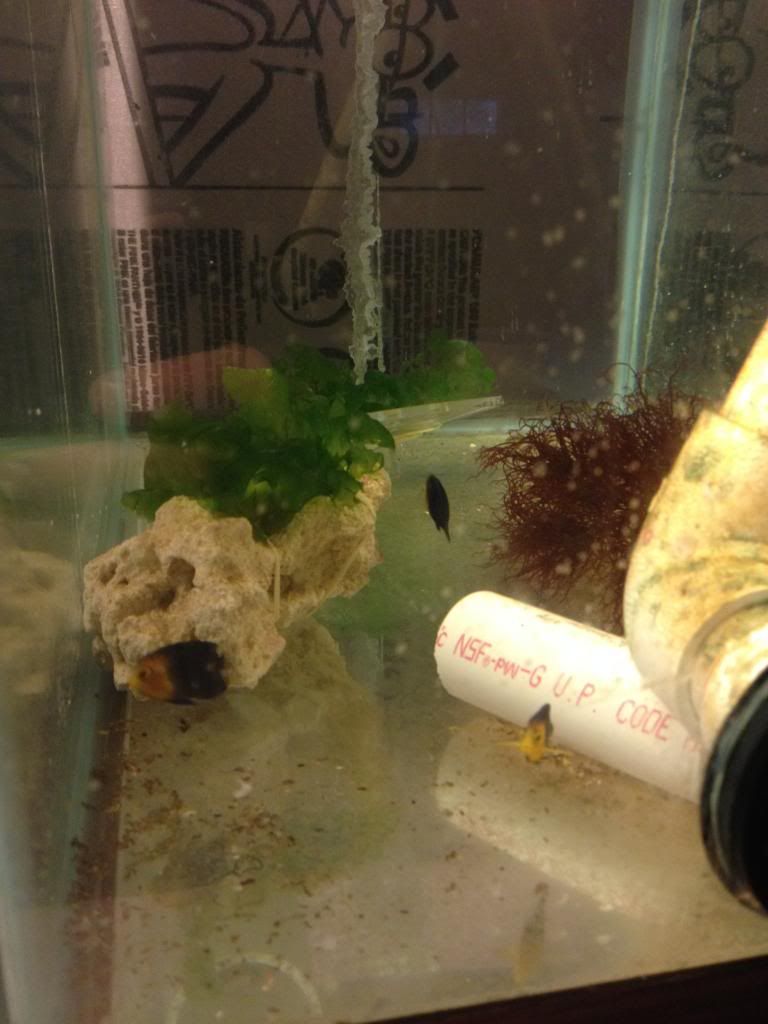 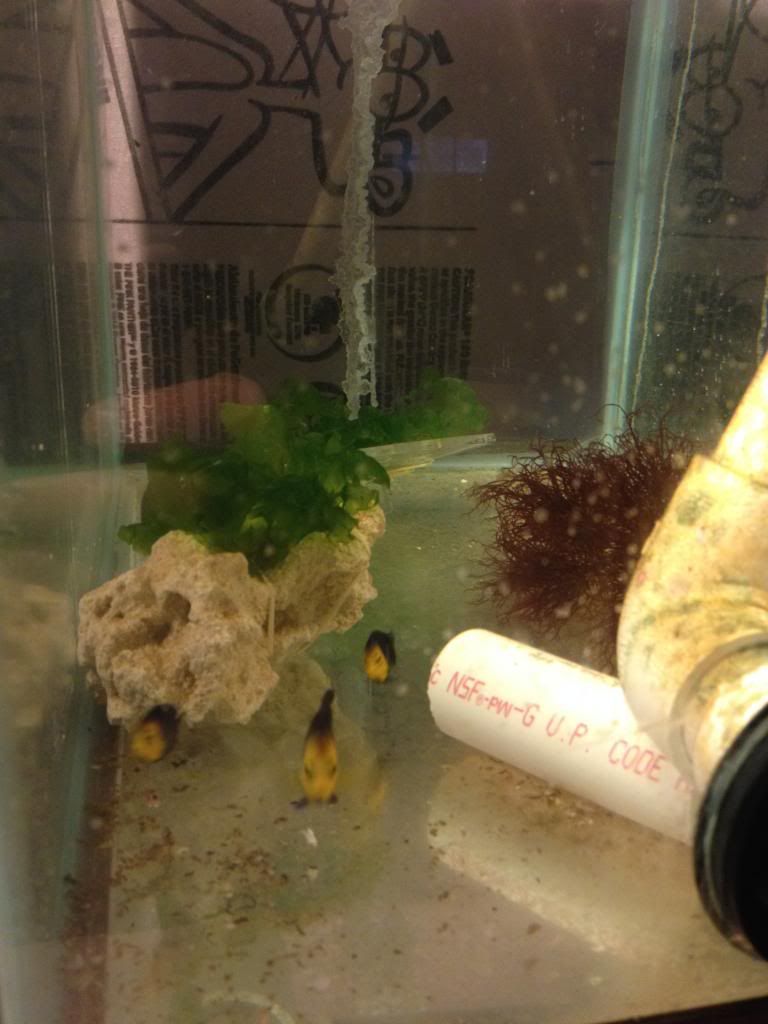 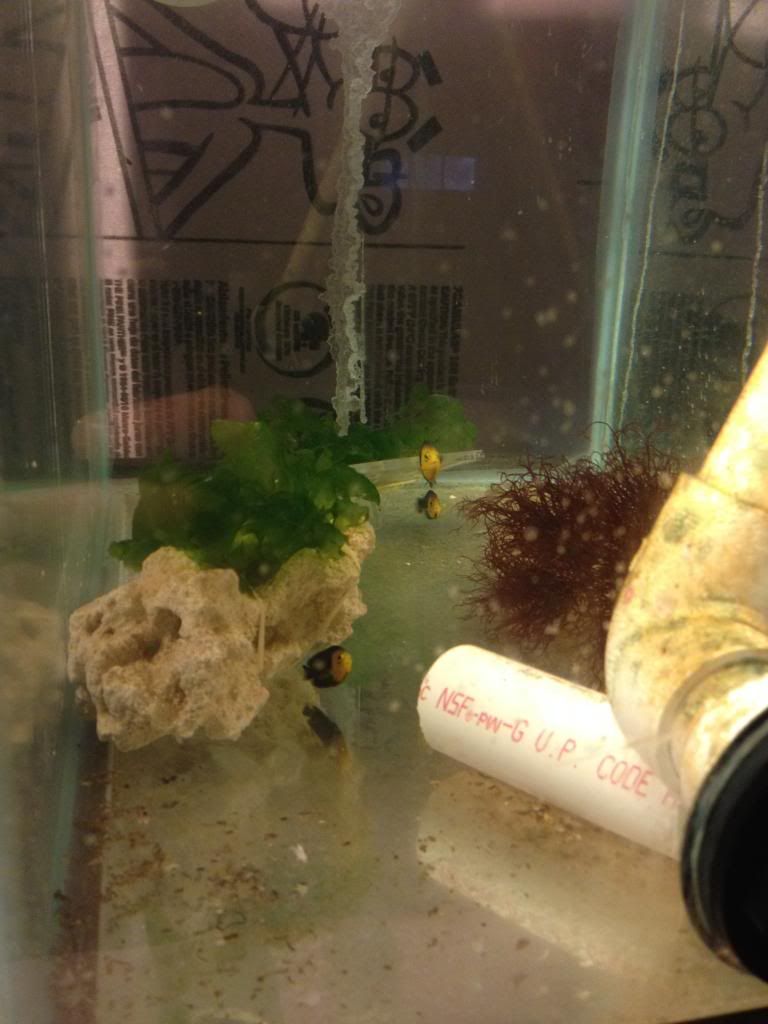 Last night I thought the larger female looked a little plump, so after lights out I went and checked with a flashlight. I had also put mesh over the standpipe to help keep any eggs in the tank. I found less than 50 and collected them into a 1/2 gallon specimen container 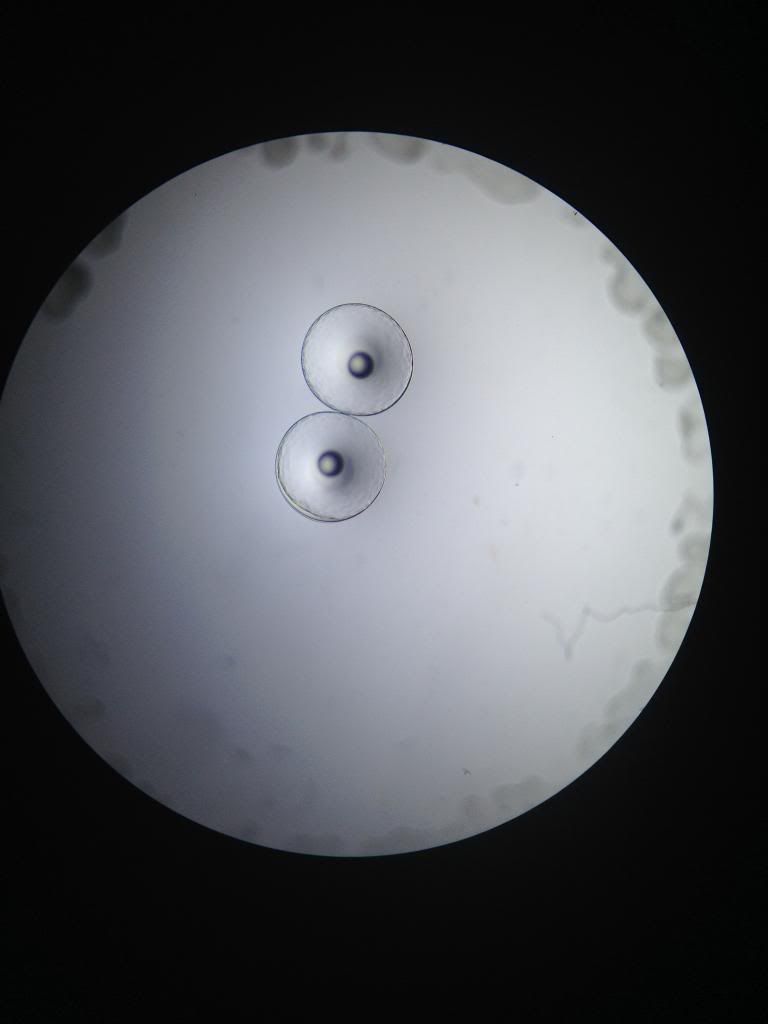 That is taken at 40x, IIRC. 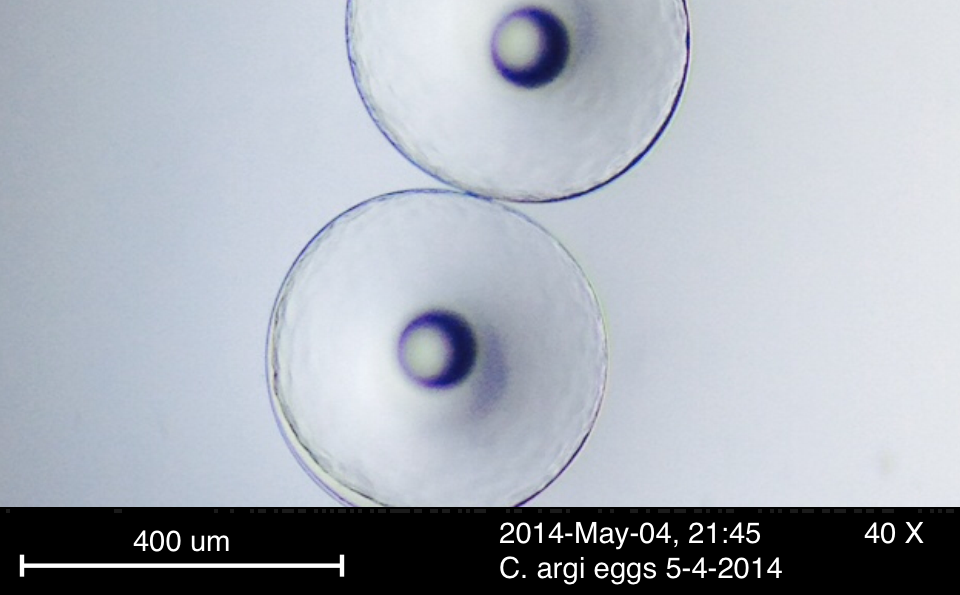 I hung the specimen container in a tank at 80F with no aeration. The tank's lid should also help keep evaporation down. This morning I pulled a few eggs off the mesh in the tank as well. I took one mesh egg, and one egg from the specimen container and checked them under the scope 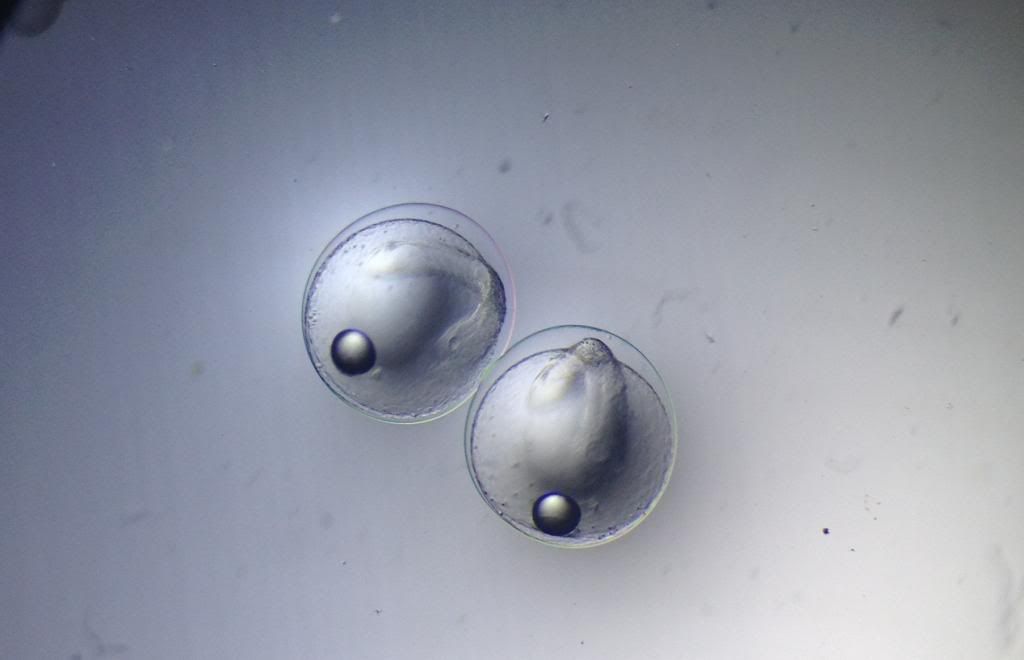 Both seem to be developing 
|
|
|
 Re: Breeding Journal, Species: Centropyge argi
Monday, May 5, 2014 7:04 PM
Re: Breeding Journal, Species: Centropyge argi
Monday, May 5, 2014 7:04 PM
( permalink)
If you have a broad spectrum antibiotic it will help hatch rates by preventing fungal attack on the eggs.
|
|
|
 Re: Breeding Journal, Species: Centropyge argi
Monday, May 5, 2014 8:00 PM
Re: Breeding Journal, Species: Centropyge argi
Monday, May 5, 2014 8:00 PM
( permalink)
I don't have one handy....but may pick some up this weekend. Hatch some time today...not sure of the exact time and I only spotted a few. I will probably remove the bad eggs tonight since there are quite a few laying on the bottom. 40x: 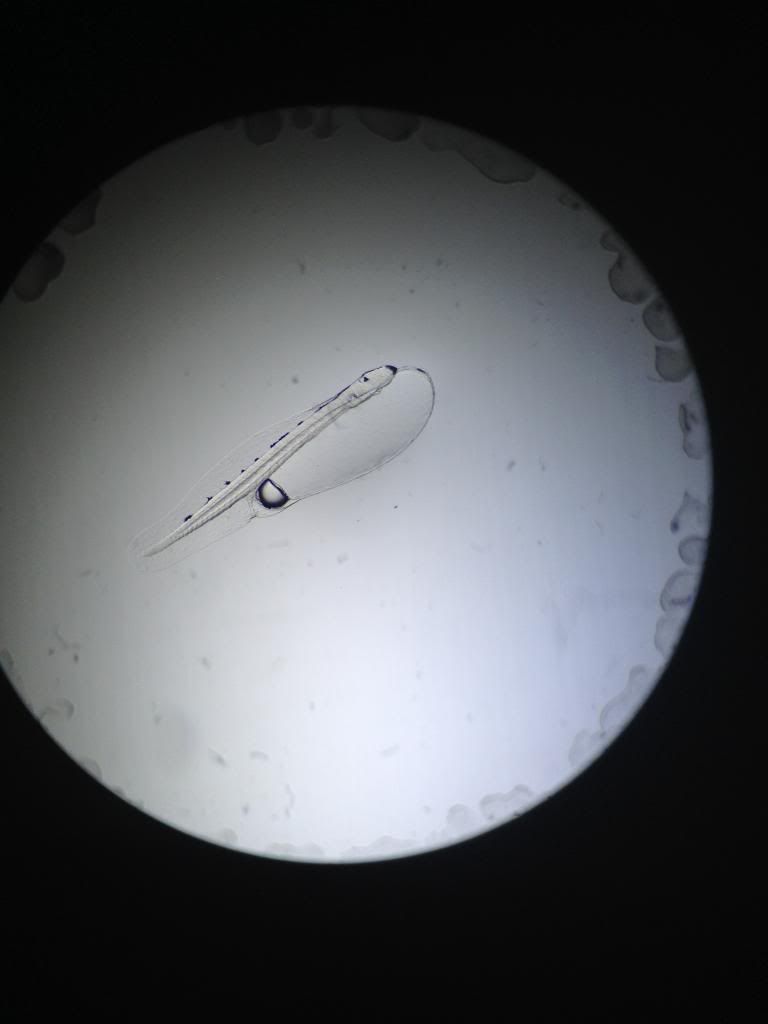 100x: 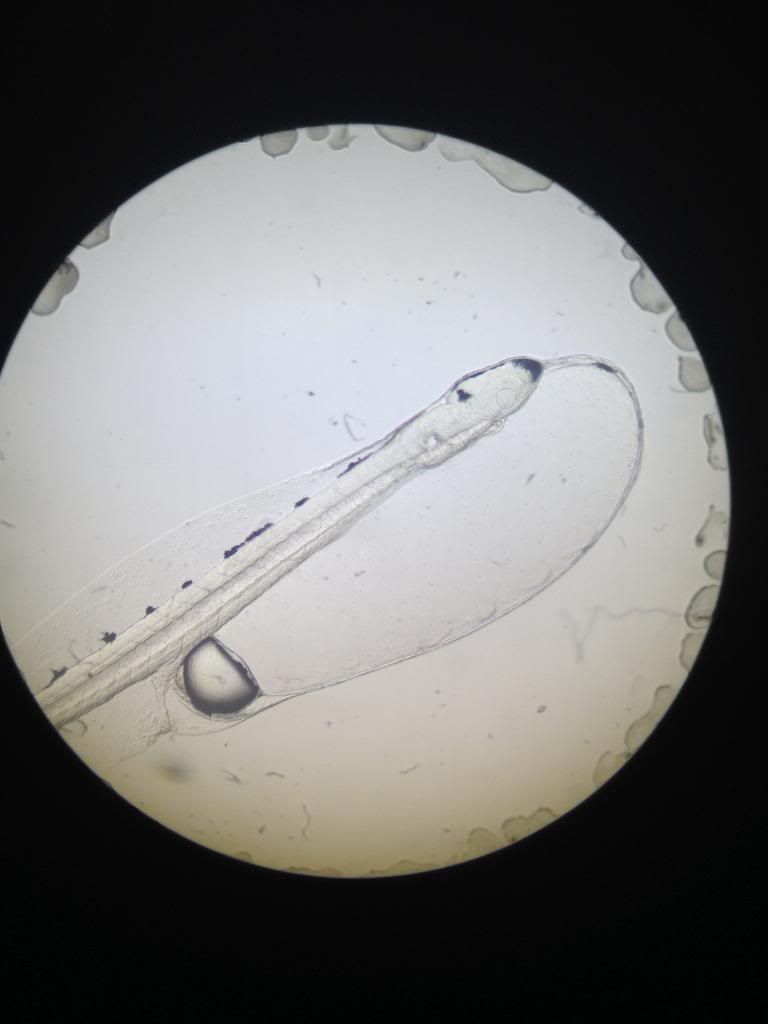 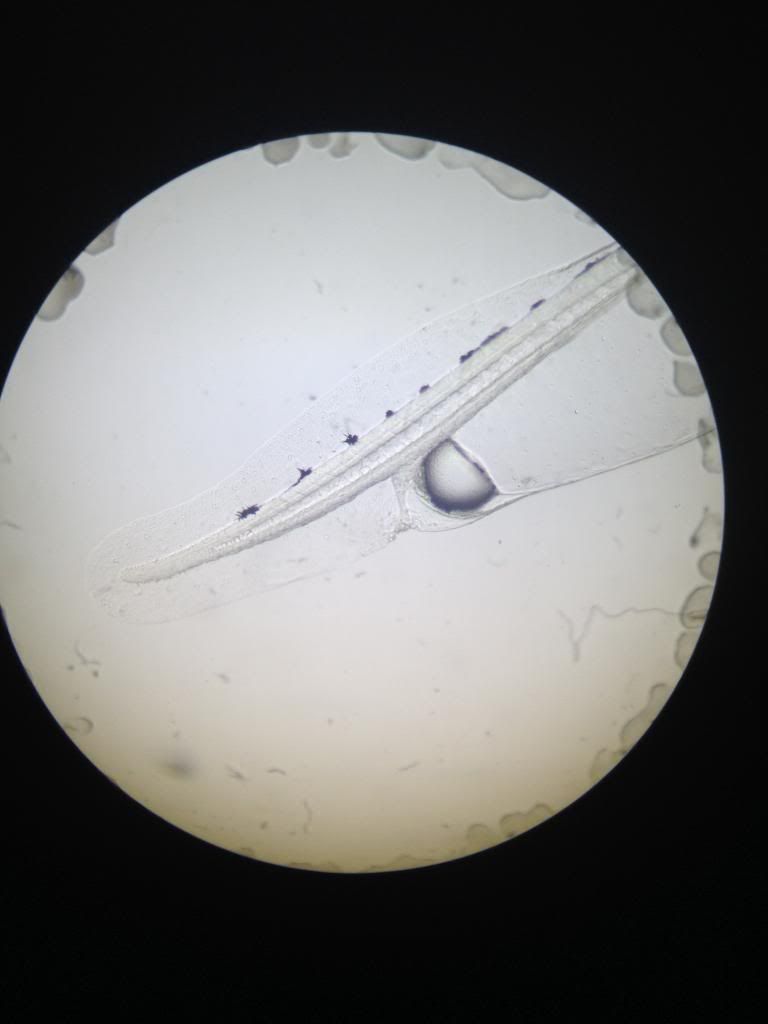
|
|
|
 Re: Breeding Journal, Species: Centropyge argi
Tuesday, May 6, 2014 10:56 AM
Re: Breeding Journal, Species: Centropyge argi
Tuesday, May 6, 2014 10:56 AM
( permalink)
great pictures. do you have a parvo culture ready for first food?
|
|
|
 Re: Breeding Journal, Species: Centropyge argi
Tuesday, May 6, 2014 11:44 AM
Re: Breeding Journal, Species: Centropyge argi
Tuesday, May 6, 2014 11:44 AM
( permalink)
I have one on the way...again. I keep killing the culture. I will get it this time though  I also don't expect to get decent hatch numbers for awhile. I don't have many eggs to start with yet (the spawns are still pretty small) and only a few hatch out. So while I get the culturing down, I will continue to work on feeding the adults, collection, hatching, and incubating until they can feed.
|
|
|
 Re: Breeding Journal, Species: Centropyge argi
Tuesday, May 6, 2014 11:45 AM
Re: Breeding Journal, Species: Centropyge argi
Tuesday, May 6, 2014 11:45 AM
( permalink)
Last night was a very small spawn, hardly any eggs at all.
|
|
|
 Re: Breeding Journal, Species: Centropyge argi
Tuesday, May 6, 2014 4:29 PM
Re: Breeding Journal, Species: Centropyge argi
Tuesday, May 6, 2014 4:29 PM
( permalink)
Very cool! Awesome photos. I wish I could get some of my C. bispinosa to hatch. I'm not certain if they have been fertile thus far. I'll be following to see how the larval rearing progresses!
|
|
|
 Re: Breeding Journal, Species: Centropyge argi
Tuesday, May 6, 2014 10:57 PM
Re: Breeding Journal, Species: Centropyge argi
Tuesday, May 6, 2014 10:57 PM
( permalink)
Ken, from what I remember, centropyge eggs were nearly 100% fertile for me. This was 25 years ago and I never looked at them under a microscope but that's my story and I'm sticking to it! But seriously, I don't think infertile eggs are the problem.
|
|
|
 Re: Breeding Journal, Species: Centropyge argi
Tuesday, May 6, 2014 10:57 PM
Re: Breeding Journal, Species: Centropyge argi
Tuesday, May 6, 2014 10:57 PM
( permalink)
Thanks  I checked both specimen cups this evening. The one with eggs collected from last night didn't seem to have anything in it, so I dumped and cleaned it. The cup from the first spawn still had at least one of the two prolarvae cruising around. I was too nervous to take it out for pics though. No new spawn tonight, but I doubt they will spawn often/well mid week for me. I don't get to feed as often during the week as I do on Fri/Sat/Sun. So I am guessing the weekends are when I will be able to get sizeable spawns to work with. But I'll still probably check most nights...
|
|
|
 Re: Breeding Journal, Species: Centropyge argi
Tuesday, May 6, 2014 11:03 PM
Re: Breeding Journal, Species: Centropyge argi
Tuesday, May 6, 2014 11:03 PM
( permalink)
I never worked with C. argi so I can't help with anything that may be particular to them. But for the brilliant Hawaiian pioneers who have worked with all the Centropyge species, parvo seemed to work for every Centropyge. The problem hasn't been first food, it is second food. After 6-8 days the parvo copepodites jump faster than the Centropyge larvae can strike and it is slow starvation from then until they are all gone by day 10 or 12, depending on temperature.
The only success (that has been shared) from that point has come from wild caught plankton. To my knowledge there is no cultured organism that has worked as a second food for pygmy angels.
|
|
|
 Re: Breeding Journal, Species: Centropyge argi
Tuesday, May 6, 2014 11:14 PM
Re: Breeding Journal, Species: Centropyge argi
Tuesday, May 6, 2014 11:14 PM
( permalink)
I'm no expert, but I'd guess that the eggs have been gestating in the female for a while and depend less on her food consumption over the weekend and probably depend more on her caloric intake and fat buildup over weeks or months. I could be completely wrong on this, perhaps eggs are formed every 24 hours, but that's not my guess.
|
|
|
 Re: Breeding Journal, Species: Centropyge argi
Wednesday, May 7, 2014 11:18 PM
Re: Breeding Journal, Species: Centropyge argi
Wednesday, May 7, 2014 11:18 PM
( permalink)
The two pro larvae that hatched for me from the first spawn are still alive as if this evening. I pulled one for a pic (will post it tomorrow) and I suspect/worry that I killed it in the process. I'm not quite sure if the mouth is fully formed since I couldn't get a good angle while it was under the scope. To the eye, at this point, they are slightly easier to see since some black pigmentation has developed. I may try adding some Parvo naups tomorrow morning along with a dinoflagellate.
There was a spawn tonight and I collected about 75 good eggs. I collected everything I could with a turkey baster in a specimen cup. Then I used a small pipet to count the eggs as I put them in a smaller container. This allowed me to end up with just the eggs that floated well and not collect so much random stuff from the broodstock tank. I took a ~1.5 gallon wineglass (I'll try to get a pic) and filled that with broodstock water (put through at 120 micron sieve) and then put that into a water bath (dishpan) that is heated to 80F. I put a lid on the wineglass to limit evaporation.
Hopefully I will get a better hatch than I did with my first attempts.
|
|
|
 Re: Breeding Journal, Species: Centropyge argi
Thursday, May 8, 2014 8:41 AM
Re: Breeding Journal, Species: Centropyge argi
Thursday, May 8, 2014 8:41 AM
( permalink)
Still had one prolarva (or perhaps larva, at this point!) in the specimen cup this morning at lights on. I added some Isochrysis and some Parvocalanus naups, however, those nauplii are already several days old and may already be too large. Tonight I will sieve the adult culture and try to get some younger ones (if the larva is still alive...) Here is the pic from last night. Not the best, but I didn't want to keep it out of the water long. 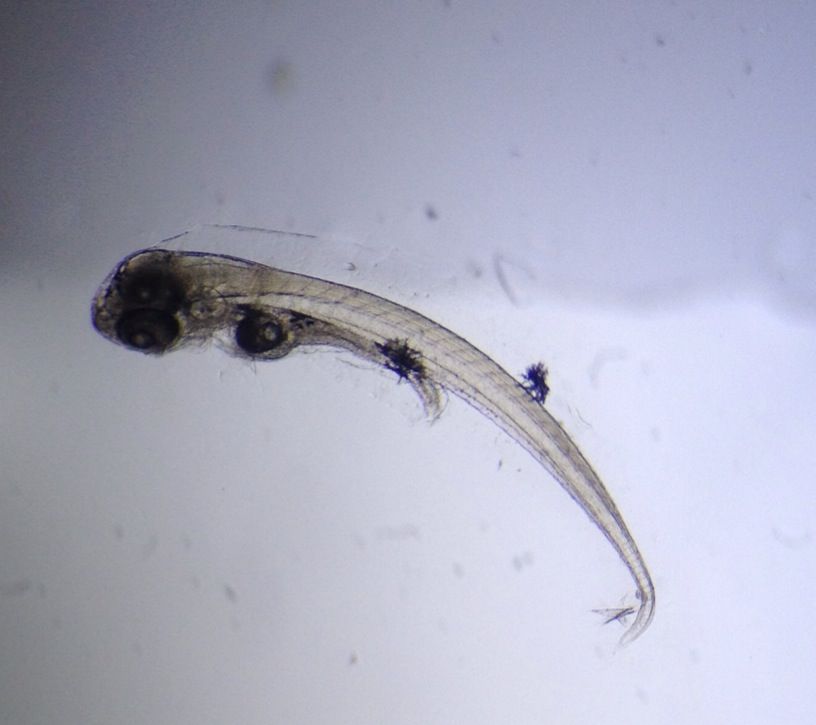 The eggs from the spawn last night are still floating and don't look opaque, so I am hoping they are still good. They are all around the meniscus of the wineglass. The temp dropped a little more than I wanted it to (I just set everything up last night and wasn't sure how exact the heater setup I made was going to be) so I turned the heater up a little bit this morning. I will be home today around 1-2, so perhaps I will get a chance to see if they hatch before I head back to work.
|
|
|
 Re: Breeding Journal, Species: Centropyge argi
Thursday, May 8, 2014 12:27 PM
Re: Breeding Journal, Species: Centropyge argi
Thursday, May 8, 2014 12:27 PM
( permalink)
 Originally Posted by dave w
I never worked with C. argi so I can't help with anything that may be particular to them. But for the brilliant Hawaiian pioneers who have worked with all the Centropyge species, parvo seemed to work for every Centropyge. The problem hasn't been first food, it is second food. After 6-8 days the parvo copepodites jump faster than the Centropyge larvae can strike and it is slow starvation from then until they are all gone by day 10 or 12, depending on temperature.
The only success (that has been shared) from that point has come from wild caught plankton. To my knowledge there is no cultured organism that has worked as a second food for pygmy angels.
I was just reading over this paper again "Development of aquaculture technology for the flame angelfish, Centropyge loriculus" by Charles W. Laidley, Chatham K. Callan, Andrew Burnell, Kenneth K.M. Liu, Christina J. Bradley, Marta Bou Mira, and Robin J. Shields. Although they were able to rear on just Parvocalanus, followed by artermia, they suffered high mortality rates. They suggest that the nauplii possibly weren't able to meet the nutritional requirements. They also state that finding a transitional food needs work because they weren't able to get them onto rotifers, but then comment that "it is challenging to maintain sufficient numbers of larger copepodites." So for that species, it sound like to me that it isn't so much that the larvae couldn't handle the larger copepodites but rather that the researchers weren't able to provide enough of them. It's all very interesting and one has to wonder then if a copepod species with a larger nauplii would work. I would probably try Euterpina since I have that handy. But that is all WAY WAY WAY down the road since right now I am still dealing with egg collection, hatching, and prolarvae incubation improvements and potential first feedings 
|
|
|
 Re: Breeding Journal, Species: Centropyge argi
Thursday, May 8, 2014 8:25 PM
Re: Breeding Journal, Species: Centropyge argi
Thursday, May 8, 2014 8:25 PM
( permalink)
I was home around 12 today and I didn't find many eggs. There were a few on the bottom of the container which I siphoned out. I also siphoned out egg casings and upon closer inspection I realized they had already hatched. Several prolarvae were cruising around. I added some Parvo of all ages and Iso. Here is a pic of the wineglass/water bath   The spawn from 5-4 still has the one larva alive. I also added Parvo of all ages to that specimen container, along with some Iso, but not very much of the Parvo so this little guy isn't likely to make it too long. Still no aeration for either container.
|
|
|
 Re: Breeding Journal, Species: Centropyge argi
Thursday, May 8, 2014 10:55 PM
Re: Breeding Journal, Species: Centropyge argi
Thursday, May 8, 2014 10:55 PM
( permalink)
I just found the last larva from the 5-4 spawn dead on the bottom of the specimen container. So that is about 72-80 hours post hatch.
There was a spawn tonight, but I didn't collect any eggs. I want to wait and see how last night's spawn develops before I collect more eggs and I'm also tired so I didn't feel like monkeying around with it tonight. Tomorrow I may collect since I'll have a specimen cup available again. Maybe.
|
|
|
 Re: Breeding Journal, Species: Centropyge argi
Friday, May 9, 2014 10:03 AM
Re: Breeding Journal, Species: Centropyge argi
Friday, May 9, 2014 10:03 AM
( permalink)
Frank at RCT used parvo as a first food, but he also fed the angelfish Oithona (sp?). I haven't looked into their survival rates, but that is what I have gathered. While they have worked with many Centropyge, there are still many more to be worked with like C. venusta (Karen is on settlement), C. narcosis, C. bispinosa, C. nox, C. Deborae, etc.
|
|
|
 Re: Breeding Journal, Species: Centropyge argi
Friday, May 9, 2014 11:37 PM
Re: Breeding Journal, Species: Centropyge argi
Friday, May 9, 2014 11:37 PM
( permalink)
I think parvo and oithona are similarly sized and would guess that either could be used. Although adult copepods can be identified, it is nearly impossible to identify naups. Yet there are critical factors about the naups that affect larval survivability like shape, swimming motion, the number and types of tail barbs. I don't think you'd go wrong using both of these small copepods.
However I have some healthy skepticism that the Hawaiians went from parvo straight to new hatched brine shrimp. I think it is more likely that they went from parvo to size sorted wild collected copepods to artemia. I don't know the date of the paper but perhaps less than full information was published while people were in the process of trying commercial culture of flame angels. I could be wrong, it won't be the first time today.
|
|
|
 Re: Breeding Journal, Species: Centropyge argi
Saturday, May 10, 2014 2:03 AM
Re: Breeding Journal, Species: Centropyge argi
Saturday, May 10, 2014 2:03 AM
( permalink)
Where is David Watson when you need him? I've never heard that "wild plankton only" gets you past day 8 with Centropyge, and I can tell you that while Watson is up against his own issues, he's going well past 20 days....
|
|
|
|